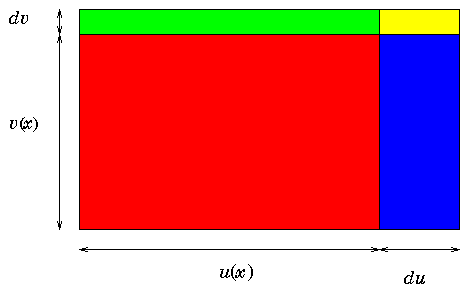 The Product Rule
The Product Rule
We'd like to be able to take the derivatives of products of functions
whose derivatives we already know. For example
f(x)=(x-2)(x-1) is a
product of two functions, u(x)=x-2
and v(x)=x-1, both of whose
derivatives we know to be 1. Wouldn't it be nice if the derivative of
a product was the product of the derivative, as it is for sums?
Unfortunately, this is not the case;

and in this quite simple case, it is easily seen that the derivative
of a product is NOT the product of the
derivatives.
Although this naive guess wasn't right, we can still figure out what
the derivative of a product must be. Remember: When intuition fails,
apply the definition. Consider
 Now we apply the trick of adding zero, in the form of
u(x+h)v(x)
-u(x+h)v(x) to
the numerator, and after performing some minor algebra,
Now we apply the trick of adding zero, in the form of
u(x+h)v(x)
-u(x+h)v(x) to
the numerator, and after performing some minor algebra,
 In the last step,
In the last step,
 because u(x) is differentiable at x and therefore
ontinuous.
because u(x) is differentiable at x and therefore
ontinuous.
A good way to remember the product rule for differentiation is ``the
first times the derivative of the second plus the second times the
derivative of the first.'' It may seem non-intuitive now, but just see,
and in a few days you'll be repeating it to yourself, too.
Another way to remember the above derivation is to think of the
product u(x)v(x) as the
area of a rectangle with width u(x) and height
v(x). The change in area is
d(uv), and is indicated is the figure below.
 As x changes, the area changes from the area of the red
rectangle, u(x)v(x), to
the area of the largest rectangle, the sum of the read, green, blue
and yellow rectangles. The change in area is the sum of the areas of
the green, blue and yellow rectangles,
As x changes, the area changes from the area of the red
rectangle, u(x)v(x), to
the area of the largest rectangle, the sum of the read, green, blue
and yellow rectangles. The change in area is the sum of the areas of
the green, blue and yellow rectangles,
 In the limit of dx small, the area of the yellow rectangle
is neglected. Algebraically,
In the limit of dx small, the area of the yellow rectangle
is neglected. Algebraically,
 ``Neglecting'' the yellow rectangle is equivalent to invoking the
continuity of u(x) above. This argument cannot
constitute a rigourous proof, as it uses the differentials
algebraically; rather, this is a geometric indication of why the
product rule has the form it does.
``Neglecting'' the yellow rectangle is equivalent to invoking the
continuity of u(x) above. This argument cannot
constitute a rigourous proof, as it uses the differentials
algebraically; rather, this is a geometric indication of why the
product rule has the form it does.
Some examples:
- We can use the product rule to confirm the fact that the derivative
of a constant times a function is the constant times the derivative of
the function. For c a constant,


Whether or not this is substantially easier than multiplying out the
polynomial and differentiating directly is a matter of opinion;
decide for yourself.
- If f and g are differentiable functions
such that f(2)=3, f´(2)=-1,
g(2)=-5 and g´(2)=2, then what is the value of
(fg)´(2)?

Exercises:
- With

what is g´(x)?
- If f, g and h are differentiable, use
the product rule to show that
 As a corollary, show that
As a corollary, show that
 This is a special case of the chain rule.
This is a special case of the chain rule.
- Find dy/dx where

Solutions to the exercises |
Back to the Calculus page |
Back to the World Web Math top page
watko@mit.edu
Last modified February 11, 2003.
 The Product Rule
The Product Rule The Product Rule
The Product Rule












